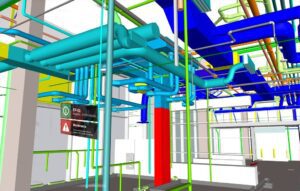Building Information Modeling (BIM) is revolutionizing the construction industry by transforming project planning, design, construction, and maintenance processes. At JMKON, we leverage BIM not just as a 3D digital modeling tool but as a comprehensive solution that enhances Construction Management from start to finish. By integrating BIM into our services, we streamline workflows, improve collaboration, and optimize project outcomes.
Know more about benefits of building information modeling.
The Role of BIM in Project Lifecycle and Construction Management

BIM and Lifecycle Management in Construction
BIM is revolutionizing lifecycle management by integrating data at every phase, from initial design to post-construction maintenance.
At JMKON, we leverage BIM to ensure each stakeholder has access to accurate, up-to-date information, helping to reduce delays and improve decision-making throughout the project lifecycle.
Managing Project Planning, Construction, and Maintenance with BIM
From detailed planning and design to construction and ongoing facility maintenance, BIM acts as the backbone for all our processes.
By centralizing data, we streamline workflows, which enables better coordination and significantly reduces the risk of errors or rework.
BIM for Project Stakeholders in Construction
BIM allows all project stakeholders—architects, engineers, contractors, and clients—to collaborate in real-time.
This integrated approach facilitates better communication, which minimizes discrepancies and enhances project efficiency.
The Role of BIM in Building Information Management
One of the core benefits of BIM is in the management of building information. From material specifications to structural data and performance metrics, BIM stores and manages a project’s complete lifecycle data, enabling more effective future maintenance and upgrades.
The Role of BIM in Data Analytics
BIM is more than a 3D model; it’s a data powerhouse. By integrating data analytics, JMKON can make data-driven decisions that optimize everything from material usage to cost-efficiency. These insights ensure that each project is both efficient and sustainable.
Time and Scheduling Integration
At JMKON, we use BIM to integrate time and scheduling elements seamlessly into our construction plans. This allows us to anticipate potential delays and proactively adjust schedules, keeping projects on time and within budget.
Cost Estimation and Budgeting
BIM helps ensure that cost estimation and budgeting are accurate from the earliest stages of a project. By incorporating real-time data into our budgeting processes, we deliver projects with more predictable financial outcomes, minimizing the risk of unexpected expenses.
Sustainability and Energy Efficiency
One of BIM’s most significant contributions to the construction industry is its role in enhancing sustainability. At JMKON, we use BIM to model energy-efficient buildings, reduce material waste, and ensure sustainable practices throughout the construction process.
BIM in Residential Construction
While BIM is commonly associated with large-scale commercial projects, its role in residential construction is increasingly significant. By using BIM, JMKON enhances the design and construction of homes, ensuring greater precision, sustainability, and energy efficiency while reducing costs for homeowners.
BIM in Infrastructure and Civil Engineering
In the realm of infrastructure and civil engineering, BIM enables the visualization of complex projects such as bridges, tunnels, and roads. By using BIM, we ensure that every element of the project is planned and executed to the highest standards, reducing the likelihood of delays and cost overruns.
BIM for Commercial Projects
For commercial projects, BIM provides the tools to manage intricate details across large-scale developments. This includes everything from HVAC system designs to electrical plans, ensuring that every facet of the project is aligned and efficiently executed.
Embracing the Future with BIM
Future Trends in BIM
As technology continues to evolve, so does BIM. At JMKON, we are excited about the potential advancements in BIM that will shape the future of construction. Trends such as AI-driven analytics, IoT integration, and cloud-based collaboration are already transforming how projects are designed and managed. These technologies enable real-time insights and more informed decision-making, pushing the boundaries of what’s possible in construction.
BIM and Smart Cities
BIM is playing a pivotal role in the development of Smart Cities, where interconnected data systems manage everything from traffic flow to energy consumption. As cities grow, BIM will be crucial in planning and maintaining the infrastructure that supports this growth.
BIM and Artificial Intelligence in Construction
AI-powered BIM tools are enabling smarter and faster decision-making. From predicting project risks to automating design processes, AI in BIM enhances efficiency while ensuring superior project outcomes.
BIM and the Internet of Things (IoT)
The integration of IoT with BIM is allowing real-time monitoring of building performance. Sensors embedded in buildings can track everything from energy usage to structural integrity, enabling proactive maintenance and improving long-term sustainability.
BIM and Virtual Reality (VR) / Augmented Reality (AR)
The combination of BIM with VR/AR technologies is revolutionizing how we visualize projects. From immersive design reviews to on-site construction simulations, VR/AR enables stakeholders to experience the project before it’s built, facilitating better planning and collaboration.
BIM in the Cloud
Cloud-based BIM systems allow teams to collaborate from anywhere in the world, making project data accessible in real-time. This accessibility reduces delays and ensures that all stakeholders are aligned on the latest project developments.
BIM for Green Building Certifications (LEED, BREEAM)
BIM is a valuable tool in achieving Green Building Certifications like LEED and BREEAM. By providing precise data on energy performance, water usage, and material sustainability, BIM ensures that our projects meet the highest environmental standards.
BIM and Sustainable Materials Management
Sustainability is a core value at JMKON, and BIM helps us track and manage materials efficiently. By optimizing material usage, we reduce waste, save costs, and contribute to a more sustainable construction process.
BIM and Lifecycle Carbon Footprint Analysis
With BIM’s lifecycle analysis capabilities, we can measure a building’s carbon footprint from construction to operation. This helps our clients meet sustainability goals and comply with increasingly stringent environmental regulations.
Know more about using BIM in facilities management.
What are the challenges of implementing BIM?

Training Teams and Stakeholders for a Smooth Transition to BIM
- Addressing Resistance to Change:
- JMKON’s Approach: JMKON offers customized onboarding and educational programs designed to ease teams into the BIM process. These programs emphasize practical benefits and provide ongoing support to reduce resistance and foster enthusiasm for new methods.
- Comprehensive Training Programs:
- JMKON’s Benefit: JMKON delivers tailored training workshops for all stakeholders, ensuring that designers, engineers, contractors, and project managers are well-versed in BIM tools and workflows. Our hands-on training includes real-world simulations that build confidence and close knowledge gaps.
- Leadership Support:
- JMKON’s Value: JMKON works directly with leadership teams to communicate the long-term value of BIM. We provide detailed ROI analyses, case studies, and examples showing how BIM improves collaboration, reduces costs, and enhances project outcomes, securing buy-in from decision-makers.
- Gradual Adoption:
- JMKON’s Strategy: To ensure a smooth transition, JMKON recommends and assists with phased BIM implementation. Starting with smaller projects or pilot programs, we guide teams through the learning process, minimizing disruptions and allowing them to build competency before scaling up.
Legal Issues in BIM Implementation for the US Market
- Ownership of the BIM Model:
- JMKON’s Legal Expertise: JMKON helps draft clear contracts that specify BIM model ownership and data usage rights, ensuring that all parties understand their responsibilities regarding data sharing and modifications.
- Data Responsibility and Accuracy:
- JMKON’s Precision Standards: Our consultants work closely with stakeholders to establish clear data responsibility protocols, reducing errors. JMKON provides guidance on how to validate and verify data accuracy at every project stage.
- Liability for Errors and Omissions:
- JMKON’s Risk Mitigation: JMKON collaborates with legal teams to ensure that liability for errors and omissions is clearly defined in contracts. We help develop workflows that distribute responsibility and minimize risks associated with collaborative BIM environments.
- Contractual Frameworks for Collaboration:
- JMKON’s Contractual Support: JMKON assists in adopting frameworks like Integrated Project Delivery (IPD) or Design-Build (DB), aligning risks, roles, and rewards in line with BIM’s collaborative nature, making the process more seamless.
- Compliance with US Regulations and Standards:
- JMKON’s Compliance Expertise: Our team ensures that BIM implementation follows US standards like NBIMS-US™ and federal, state, and local government requirements, reducing legal risks in public and private sector projects.
- Data Security and Privacy:
- JMKON’s Security Solutions: JMKON provides advanced data protection strategies, including robust cybersecurity measures, to safeguard sensitive project data. We assist with developing compliance protocols to meet US privacy laws like CCPA.
- Dispute Resolution:
- JMKON’s Dispute Resolution Support: In the event of disputes, JMKON helps navigate BIM-specific legal issues, offering mediation and arbitration support to avoid costly litigation.
By leveraging JMKON’s training programs, legal guidance, and phased adoption strategies, your teams and stakeholders can overcome common BIM challenges and smoothly transition to advanced, compliant workflows.
Learn more about the BIM misconceptions in construction
Conclusion
At JMKON, we embrace BIM as a transformative tool that empowers us to innovate, collaborate, and deliver projects with unmatched efficiency and quality. As we continue to integrate cutting-edge trends such as AI, IoT, and cloud technology, we remain committed to leveraging BIM to meet the evolving needs of our clients and the construction industry. By utilizing the full potential of BIM, we not only shape the future of construction management but also contribute to a more sustainable and prosperous industry.
For more information on how we integrate BIM into our services or to discuss your next project, feel free to contact us. Together, let’s build a future where innovation and excellence define every construction endeavor.





